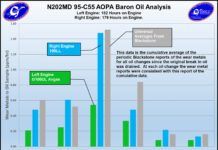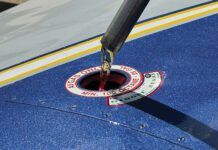Twice a week. On average, thats how often GA pilots run out of gas. One reason for this-we surmise-is that pilots either don’t know how to manage fuel or they just do it poorly. The iffy gas gauges found in typical legacy airplanes aggravate the problem.
Although the real reason for fuel exhaustion lies between the pilots ears, there’s a not-too-expensive upgrade that can help: a fuel totalizer. It will provide instantaneous fuel consumption data along with fuel remaining, endurance and, perhaps most important, a reliable indication of lean state. With gas at $6 a gallon, you need all the help you can get.

When connected to a loran or GPS, a totalizer can supply distance-to-empty and reserve-at-destination information, along with your real-time mileage. Most fuel totalizers are stand-alone products; others require either a compatible GPS or an installed engine monitor to do their thing. Either way, none will guarantee you wont run out of fuel, but you’ll have to work at it.
How They Work
Totalizers count the impulses generated by a fuel-line mounted transducer and convert the information into fuel consumption. Presuming the device knows how much fuel is aboard, is configured properly and there are no leaks, any totalizer worthy of the name will display the real-time gallons, pounds, liters or other measurement unit per hour flowing into the engine.
It will work with mogas, avgas or Jet A, although a higher-capacity transducer may be required for larger or turbine engines. A totalizer should display the endurance remaining until empty tanks, expressed in time, but its still up to the pilot to enter into the unit the correct fuel amount aboard and to switch tanks as appropriate to ensure the available fuel gets to the engine.
A standalone totalizer installed in a non-pressurized single requires only a suitable cut-out in the instrument panel, passing three wires through the firewall and connecting them to the transducer, bolting the transducer to the top of the engine and installing a hose and appropriate fittings in the fuel line. A dedicated circuit breaker and appropriate wiring may also be necessary.
But some aircraft-those with pressure carburetors, for example, and some fuel injection systems-return a variable amount of excess fuel to the tanks. Since this happens past the point in the system where the transducer can be installed, the totalizer wont know about the returned fuel, displaying greater consumption than the engine is actually burning. The fix is to install a second transducer in the return line, subtracting from the total, but some totalizers cant do the math.
Most totalizers accommodate only one engine. For twins, manufacturers offer an upgrade path, ensuring the totalizer counts all the gallons burned and subtracts them from the fuel onboard, while allowing the pilot to view an individual engines flow. One system, Sagems FC-10, requires an add-on box, the FT-10, to handle twins. Shadins totalizers work just fine with two engines. Then comes connecting the totalizer to the avionics. Many products can receive serial data from a loran or GPS to calculate real-time mileage, fuel remaining at destination or fuel required to the next fix. Others send their fuel flow data to the navigator, allowing it to make its own calculations. Most totalizers are available in either a standard or optional configuration, allowing them to send and receive such data.
All of the totalizers we looked at come with a supplemental type certificate for at least one aircraft; many are STCd in hundreds of aircraft types through an

approved model list and still others are standard or optional factory equipment. All comply with applicable technical standard orders. All but one of the STCs we reviewed consider the totalizer an advisory instrument. Electronics International offers a separate, higher-priced STC allowing primary instrumentation status.
Electronics International
Electronics International manufactures a full line of engine and systems instrumentation, including its FP-5 and FP-5L totalizers, the latter of which offers bidirectional communication with a loran or GPS navigator. Both also are available in versions STCd for use as primary instrumentation, at a higher price, something no other manufacturer offers. (Using a different totalizer as primary instrumentation requires a field approval, something often left to your local FSDOs whim.)
Either device also can be used when the aircrafts systems require applying a differential to the basic data stream by installing a $395 add-on unit for subtracting the differential from the fuel flow and another for adding to it. Thus, the FP-5 and -5L can accommodate pressure carbs and oddball fuel injection systems as we’ll as combustion heaters, although two complete systems are required for twin-engine aircraft. Additionally, the two units incorporate an auxiliary data channel: If you want fuel pressure on your instrument, for example, EI can fix you up.
Electronics International manufactures its own transducer, saying it has benefits over the industry-standard product sold by Floscan and packaged by avionics makers (see sidebar at right). The company says it hand-assembles its transducers inhouse and they all go out the door with the same K-factor, eliminating that step of the installation and configuration process. The FP-5 and 5L also offer multiple

configurable alarms.
Insight Instruments
Insights sole offering is the True Flow 500, taken from its TAS 1000 airdata product. Essentially, the True Flow 500 is a standard transducer with an added microprocessor, enabling communication directly with loran and GPS navigators accepting its signal. These include the Garmin GNS430/530, Bendix-King KLN89 and 90 series, plus the KLN94, and the Apollo/UPSAT GX50/60/65.
Since there’s no separate display unit, the information presented by the True Flow 500 depends entirely on the navigator to which its connected. For example, you wont see real-time fuel flow data unless your navigator is configured to display it.
J.P. Instruments
J.P. Instruments offers two fuel totalizer solutions: the standalone FS-450 and an option for new and installed EDM-700 and -800 engine monitors. Like EIs product, the FS-450 is pretty much a do-it-all instrument, at least for singles. Out of the box, it incorporates send/receive capability with most loran/GPS navigators, including Arnav/Northstar/UPSAT units, and can accommodate a second transducer to track a pressure carbs returned fuel. A twin-engine version is also available.
For installed JPI engine monitors, the company offers a fuel flow option, which basically connects a transducer and installs a three-position toggle switch, allowing the user to select the display mode. In one position, the toggle switch commands the monitor to present only individual EGT/CHT parameters plus voltage. In a second position, the monitor cycles through all temperature (EGT/CHT) values, as we’ll as fuel flow and readings from other installed sensors. In its third position, the toggle commands display of fuel flow information only.
Additionally, installing the fuel-flow option on an EDM-series engine monitor enables bidirectional communication with a loran or GPS. Like the FS-450, the EDM units can communicate with a wide variety of navigators. Finally, fuel flow information is

recorded in the EDMs memory for later download.
Sagem Avionics
Sagem Avionics is a U.S. subsidiary of France-based SAFRAN, a large multinational active in many markets, including aerospace and defense. Its FC-10 fuel computer is formerly an Arnav product; Sagem acquired Arnav in 2004 and has kept several of its products on the market. The FC-10 is standard equipment on Socatas TBM-700 turbine single.
The FC-10 includes enough smarts to export fuel flow data to a compatible loran or GPS navigator as a standard feature; Sagem says all lorans and GPS navigators are compatible. In addition, it provides traditional totalizer functions. Unique among the totalizers in this round-up, the FC-10 is compatible with twin-engine aircraft as long as its companion FT-10 is installed. The FT-10 monitors the second engine and forwards the results to the FC-10, where more number-crunching is performed. The FT-10 requires a second 2.25-inch instrument hole.
Shadin Avionics
Perhaps the household name by which many fuel flow instruments are compared, Shadin Avionics offers three distinct totalizer products: the Digiflo-L, Miniflo-L and Microflo-L, the “-L” denoting ability to communicate bidirectionally with a loran or GPS navigator. The company tells us their totalizer line handles twins out of the box. Like Sagems, Shadins totalizers are OEMd to major airframe manufacturers. Shadin makes its own transducers.
With certain exceptions, all three perform essentially the same functions. A major difference is in form factor and display: The Digiflo-L requires a 3.125-inch instrument hole while the Miniflo-L requires a rectangular cutout. Both use eight-segment LEDs. Shadin says its Microflo-L, which requires a 2.25-inch hole and has

a display comprised of dot-matrix LEDs, is electronically identical to the larger Digiflo-L.
Shadins products offer the widest array of compatibility with legacy long-range navigators weve seen. While most of the other totalizers on the market work and play we’ll with Garmin, Bendix-King and maybe Apollo/UPSAT navigators, a Shadin totalizer can be configured to communicate with Northstar, Trimble, Arnav, Magellan and older navigators.
Conclusion
Totalizer choices come down to how many engines need to be monitored, price, panel space and whether you want the unit to talk with your long-range nav system. The chart on page 17 details these variables for the five companies. Check the usual suspects for better pricing or package deals.
For a single, wed go with either the EI FP-5L or the JPI FS-450: They both offer the same functionality for basically the same money. The FS-450 has a three-dollar pricing edge, but the FP-5L comes with an additional channel to which something else can be connected and we like the idea behind EIs proprietary transducers. Both should communicate with legacy navigators, for example, as we’ll as newer Garmin or Bendix-King units. Also, both units count fuel returned to a tank for those applications requiring it. If you already have a JPI engine monitor or plan to install one, adding the fuel flow option might be the way to go.
The EI FP-5/5L and JPIs FS-450 cant handle twins, though, although JPI does market a multi-engine version at a higher price. Shadins products, on the other hand, can accommodate twins while talking to the other avionics. And pricing for twins may be better than from other manufacturers, so shop around. Our only concern here is factory support-we had a heck of a time getting Shadin to supply us with basic product information. If their response is that poor before the sale, we would worry how it will be after the check clears. Another choice is JPIs add-on fuel flow option for its EDM-750 or -760 twin engine monitors.
Thirty years ago, we didnt have all these options. Thanks to the modern transducer and the microprocessors ability to count its transmitted impulses, we do. And that means fewer excuses than ever for running out of gas.




